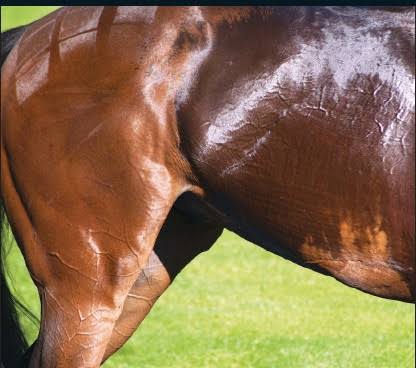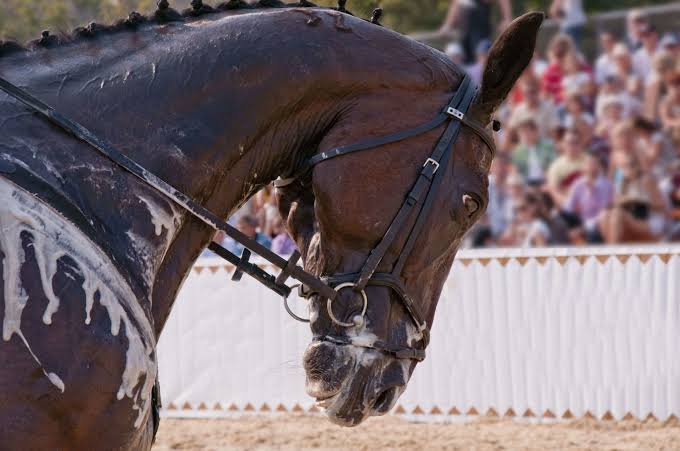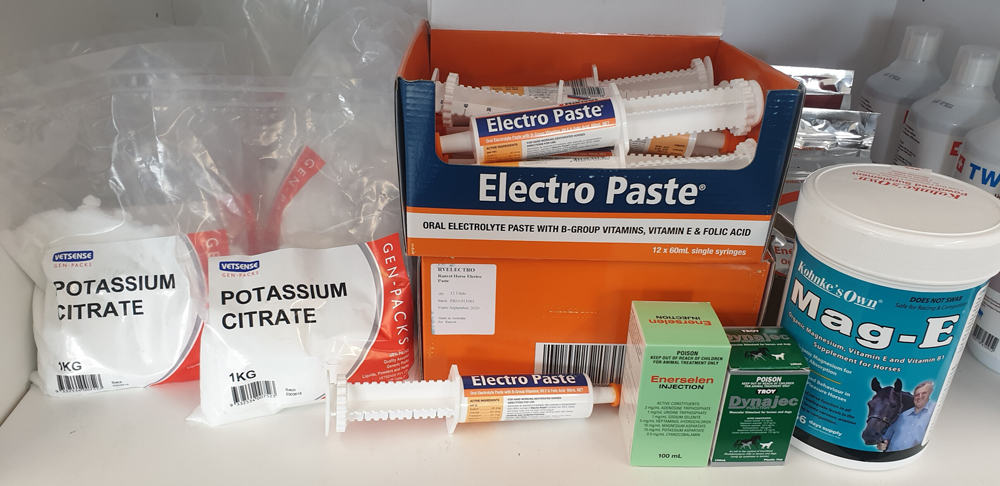Exertional rhabdomyolysis (ER or Tying-up) refers to the syndrome of muscle cramping that most often occurs during or after physical exertion or exercise. The underlying causes of this syndrome is not known specifically, but often horses are either categorized as having underlying myopathies (Chronic ER) which may be due to genetic predispositions or syndromes such as polysaccharide strorage myopathies (PSSM), or the horse has been over-exerted physically (Sporadic ER). Horses with underlying myopathies generally experience repeated episodes of ER as opposed to a single episode after a period of intense work.
Clinical Signs
- Stiffness of back muscles-muscles along spine will feel hard to touch
- Muscle tremors
- Sweating
- Reluctant to move
- Increased heart and respiratory rate
- Temperature may be increased
- Obvious signs of pain
- Raised Muscle Enzymes (CK, AST) on blood profile
- In severe cases the urine may turn brown (severe muscle damage)

Causes and triggers
Young excitable fillies are often over represented with cases of ER, and this can be related to stress induced alterations in calcium regulation within muscle cells. Reducing stress is therefore always helpful in reducing the incidence of ER. Genetically predisposed horses with conditions such as polysaccharide storage myopathies, which is a glycogen storage disease, require reduced levels of simple sugar and starches, as high levels of non-structural carbohydrates can increase the likelihood of symptoms and incidence of ER. Hot and humid weather can also cause bouts of ER, usually through alterations in electrolytes, and this can be exacerbated with high intensity exercise and overexertion.
What do to?
- If severe episode call vet-may need fluid therapy, pain relief or mild sedatives.
- Stop any intense exercise If willing to walk continue to walk/ bring for a pick of grass
- If unwilling to walk do not force it to walk
- Rug the horse if cold
- Provide water
- Give muscle supplement
- Give pain relief if needed.
- Anti-inflammatories are often indicated.
- Remove any hard feed. Only feed hay.
- When moving more freely hand walking or turnout into a small paddock is recommended.
- Continue light work the next day if able-days off after tying up are not recommended
Ongoing Management

Altering diets to reduce grain and increase fats/oils is recommended. Noting that all feeding changes should be gradually introduced over the course of a few weeks. Also, a balanced diet that meets requirements for the electrolyte minerals; sodium, chloride, potassium and magnesium and requirements for the antioxidants selenium and vitamin E. Some formulated feeds made specifically for horses that tie up are available commercially also. Attempting to reduce stress levels experienced by the horse is also beneficial in reducing the incidence of ER.
Supplements
Addition of Potassium Citrate salts into the diet increases the buffering capacity of the muscles and therefore can reduce the chance of an episode of tying up. Regular use of muscle enzyme supplements can be helpful in reducing incidence of tying up also.
The use of electrolyte pastes approximately 1-2 hours before and soon after (< 1hour) workcan help keep the essential electrolytes balanced and therefore may prevent ER.
Some evidence suggests supplements such as Thiamine, Magnesium & Chromium can have calming effects and reduce levels of stress and nervousness.


